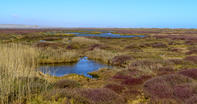Nomadic Herders
In 1957, the ‘coloured reserve’ of the Richtersveld was given a tangible boundary with the erection of a fence that ran between the communal lands and the ‘corridor’ farms along the river and the coast.

This physically curtailed the movements of the nomadic herders and drove another nail into the coffin of the old transhumance patterns. As a result of this, the remaining land became overgrazed and the subsistence lifestyle of the stock farmers became unsustainable. Many people decamped from their villages and stockposts, and moved to the mines, farms, fishing boats, towns and faraway cities to seek wage labour.
The community of the Richtersveld was in what appeared to be terminal decline. Even today, less than 10% of Nama consider themselves farmers, and most of these are elderly. The old stockposts are still inhabited but, again, it’s the old folk who remain and they are only visited by their children on weekends and holidays. After all, it’s a tough life out in the wilds.
Herders in the field have to survive on very little water, which is often brackish with high levels of fluoride and other unpalatable minerals. This causes white flecking and dark brown staining of the teeth, which is sometimes called the trademark of Namaqualand.
Rights and Obligations
Meanwhile, the diamond mining industry on the coast was flourishing. In 1989, the Alexander Bay Development Corporation was established by the government to take over all ‘assets, liabilities, rights and obligations of the… State Alluvial Diggings’.
This generous deal included ownership of the land around the Orange River Mouth and all the lovely diamonds therein. Three years later, this entity was converted by an act of parliament into a company that was named Alexcor Limited, with the government as the only shareholder. Title deeds to the land and all associated mineral rights were transferred to Alexcor by 1995.
But change was in the air. The democratic elections of 1994 ushered in a new age of land restitution and many dispossessed communities approached the new government for compensation or reclamation. Accordingly, a new act was passed, called the ‘Restitution of Land Rights Act of 1994’.
This landmark act (pardon the pun) made it possible for communities or individuals who believed they had been unjustly removed from their land to lodge a land claim “to provide for the restitution of rights in land to persons or communities dispossessed of such rights after 19 June 1913 as a result of past racially discriminatory laws or practices”. 69 000 land claims were subsequently lodged across the country.
By David Fleminger